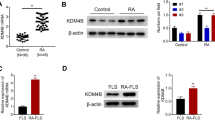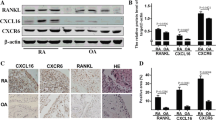Abstract
High-mobility group box 1 (HMGB1) is associated with the development of rheumatoid arthritis (RA). Recent studies have shown that methotrexate (MTX) may inhibit the expression of HMGB1. This study examined whether HMGB1 might be involved in the treatment of RA using MTX. Synovial tissues were collected from RA patients who were treated with MTX for at least 6 months (RA-MTX group, 7 cases) and from those without MTX treatment (RA-noMTX group, 7 cases). Additionally, patients with osteoarthritis (OA group, 7 cases) were used as controls. The expression and locations of HMGB1 in the tissues were detected using real-time PCR, western blot, and immunohistochemistry. Additionally, OA-fibroblast-like synoviocytes (FLSs) and RA-FLSs were isolated and cultured, and the expression of HMGB1 was reduced in these cells by transfection with HMGB1 siRNA. Cell proliferation, migration, and invasion abilities were detected. Furthermore, the effects of HMGB1 on matrix metalloproteinase (MMP)-2 and MMP-13 were measured using western blot analysis. At the tissue level, HMGB1 expression in synovial membrane did not differ significantly between the OA and RA-MTX groups, but was significantly lower in these groups than in the RA-noMTX group. In cell experiments, the cell doubling time in the RA-FLS HMGB1 siRNA group was significantly extended compared with that in the RA-FLS negative control (NC)-siRNA group. The amount of cell migration and invasion in the RA-FLS HMGB1 siRNA group was significantly lower compared with that in the NC-siRNA group; the MMP-2 and MMP-13 expression levels were also lower. These results showed that MTX reduced HMGB1 expression in RA synovial tissues, and through the downregulation of HMGB1 expression in tissues, MTX may slow disease progression of RA.




Similar content being viewed by others
References
Campbell J, Lowe D, Sleeman MA (2011) Developing the next generation of monoclonal antibodies for the treatment of rheumatoid arthritis. Br J Pharmacol 162:1470–1484
Cooles FA, Isaacs JD (2011) Pathophysiology of rheumatoid arthritis. Curr Opin Rheumatol 23:233–240
Kim HY, Park SY, Lee SW et al (2014) Inhibition of HMGB1-induced angiogenesis by cilostazol via SIRT1 activation in synovial fibroblasts from rheumatoid arthritis. PLOS One 9:e104743. doi:10.1371/journal.pone.0104743
Chirico V, Lacquaniti A, Salpietro V et al (2014) High-mobility group box 1 (HMGB1) in childhood: from bench to bedside. Eur J Pediatr 173:1123–1136
Simpson KL, Cawthorne C, Zhou C et al (2013) A caspase-3 ‘death-switch’ in colorectal cancer cells for induced and synchronous tumor apoptosis in vitro and in vivo facilitates the development of minimally invasive cell death biomarkers. Cell Death Dis 4:e163. doi:10.1038/cddis.2013.137
Voll RE, Urbonaviciute V, Herrmann M et al (2008) High mobility group box 1 in the pathogenesis of inflammatory and autoimmune diseases. Isr Med Assoc J 10:26–28
Schaper F, Heeringa P, Bijl M et al (2013) Inhibition of high-mobility group box 1 as therapeutic option in autoimmune disease: lessons from animal models. Curr Opin Rheumatol 25:254–259
Musumeci D, Roviello GN, Montesarchio D (2014) An overview on HMGB1 inhibitors as potential therapeutic agents in HMGB1-related pathologies. Pharmacol Ther 141:347–357
Tang D, Kang R, Livesey KM et al (2010) Endogenous HMGB1 regulates autophagy. J Cell Biol 190:881–892
Takahashi T, Katsuta S, Tamura Y et al (2013) Bone-targeting endogenous secretory receptor for advanced glycation end products rescues rheumatoid arthritis. Mol Med 19:183–194
Cutolo M, Sulli A, Pizzorni C (2001) Anti-inflammatory mechanisms of methotrexate in rheumatoid arthritis. Ann Rheum Dis 60:729–735
Combe B, Furst DE, Keystone EC et al (2015) Certolizumab pegol remains an equally efficacious treatment of rheumatoid arthritis over a range of background methotrexate regimens. Arthritis Care Res. doi:10.1002/acr.22676
Link AA, Kino T, Worth JA et al (2000) Ligand-activation of the adenosine A2a receptors inhibits IL-12 production by human monocytes. J Immunol 164:436–442
Kraan MC, de Koster BM, Elferink JG et al (2000) Inhibition of neutrophil migration soon after initiation of treatment with leflunomide or methotrexate in patients with rheumatoid arthritis: findings in a prospective, randomized, double-blind clinical trial in fifteen patients. Arthritis Rheum 43:1488–1495
Kuroiwa Y, Takakusagi Y, Kusayanagi T et al (2013) Identification and characterization of the direct interaction between methotrexate (MTX) and high-mobility group box 1 (HMGB1) protein. PLoS One 8:e63073. doi:10.1371/journal.pone.0063073
Altman R, Asch E, Bloch D et al (1986) Development of criteria for the classification and reporting of osteoarthritis. Classification of osteoarthritis of the knee. Diagnostic and therapeutic Criteria Committee of the American Rheumatism Association. Arthritis Rheum 29:1039–1049
Golstein RS (2008) High mobility group box-1 protein as a tumor necrosis factor-independent therapeutictarget in rheumatoid arthritis. Arthritis Res. Ther. 10:111. doi:10.1186/ar2427
Leclerc P, Wähämaa H, Idborg H et al (2013) IL-1beta/HMGB1 complexes promote the PGE2 biosynthesis pathway in synovial fibroblasts. Scand J Immunol 77:350–360
Chen Y, Sun W, Gao R et al (2013) The role of high mobility group box chromosomal protein 1 in rheumatoid arthritis. Rheumatol (Oxford) 52:1347–1739
Bossaller L, Rothe A (2013) Monoclonal antibody treatments for rheumatoid arthritis, Expert Opin. Biol Ther 13:1257–1272
Smith MD, Weedon H, Papangelis V et al (2010) Apoptosis in the rheumatoid arthritis synovial membrane: modulation by disease-modifying anti-rheumatic drug treatment. Rheumatology (Oxford) 45:862–875. doi:10.1093/rheumatology/kep467
Schierbeck H, Pullerits R, Pruunsild C et al (2013) HMGB1 levels are increased in patients with juvenile idiopathic arthritis, correlate with early onset of disease, and are independent of disease duration. J Rheumatol 40(9):1604–1613
Dolhain RJ, Tak PP, Dijkmans BA et al (1998) Methotrexate reduces inflammatory cell numbers, expression of monokines and of adhesion molecules in synovial tissue of patients with rheumatoid arthritis. Br J Rheumatol 37:502–508
Xu K, Cai YS, Lu SM et al (2015) Autophagy induction contributes to the resistance to methotrexate treatment in rheumatoidarthritis fibroblast-like synovial cells through high mobility group box chromosomal protein1. Arthritis Res Ther 17:374. doi:10.1186/s13075-015-0892-y
Mouterde G, Baillet A, Gaujoux-Viala C et al (2011) Optimizing methotrexate therapy in rheumatoid arthritis: a systematic literature review. Joint Bone Spine 78:587–592
Phillips DC, Woollard KJ, Griffiths HR (2003) The anti-inflammatory actions of methotrexate are critically dependent upon the production of reactive oxygen species[J]. Br J Pharmacol 138(3):501–511
Colebatch AN, Marks JL, van der Heijde DM et al (2012) Safety of nonsteroidal antiinflammatory drugs and/or paracetamol in people receiving methotrexate for inflammatory arthritis: a Cochrane systematic review. J Rheumatol 90:62–73
Gerards AH, Lathouder S, Groot ER et al (2003) Inhibition of cytokine production by methotrexate. Studies in healthy volunteers and patients with rheumatoid arthritis. Rheumatology 42:1189–1196
Schierbeck H, Wähämaa H, Andersson U et al (2010) Immunomodulatory drugs regulate HMGB1 release from activated human monocytes. Mol Med 16:343–351
Wang R, Zhang Q, Yang S, Guo Q (2015) TNF-α induces the release of high mobility group protein B1 through p38 mitogen-activated protein kinase pathway in microglia. Zhong Nan Da Xue Xue Bao Yi Xue Ban 40:967–972
Sundberg E, Grundtman C, Af Klint E et al (2008) Systemic TNF blockade does not modulate synovial expression of the pro-inflammatory mediator HMGB1 in rheumatoid arthritis patients—a prospective clinical study. Arthritis Res Ther 10:R33
Park YJ, Chung MK, Hwang D et al (2015) Proteomics in rheumatoid arthritis research. Immune Netw 15:177–185. doi:10.4110/in.2015.15.4.177
Roy K, Kanwar RK, Kanwar JR (2015) Molecular targets in arthritis and recent trends in nanotherapy. Int J Nanomed 10:5407–5420. doi:10.2147/IJN.S89156
Kim KS, Choi HM, Oh H, da et al (2010) Effect of taurine chloramine on the production of matrix metalloproteinases (MMPs) in adiponectin- or IL-1beta-stimulated fibroblast-like synoviocytes. J Biomed Sci 17(Suppl 1):S27. doi:10.1186/1423-0127-17-S1-S27
He ZW, Qin YH, Wang ZW et al (2013) HMGB1 acts in synergy with lipopolysaccharide in activating rheumatoid synovial fibroblasts via p38 MAPK and NF-kappaB signaling pathways. Mediators Inflamm. doi:10.1155/2013/596716
Acknowledgments
The authors are grateful for the technical advice and the collection of specimens provided by Xi Lan. This work was supported by the National Natural Science Foundations of China (Nos. 81271948 and 81171742).
Author information
Authors and Affiliations
Corresponding author
Rights and permissions
About this article
Cite this article
Li, Yb., Xu, P., Xu, K. et al. Methotrexate affects HMGB1 expression in rheumatoid arthritis, and the downregulation of HMGB1 prevents rheumatoid arthritis progression. Mol Cell Biochem 420, 161–170 (2016). https://doi.org/10.1007/s11010-016-2783-1
Received:
Accepted:
Published:
Issue Date:
DOI: https://doi.org/10.1007/s11010-016-2783-1




